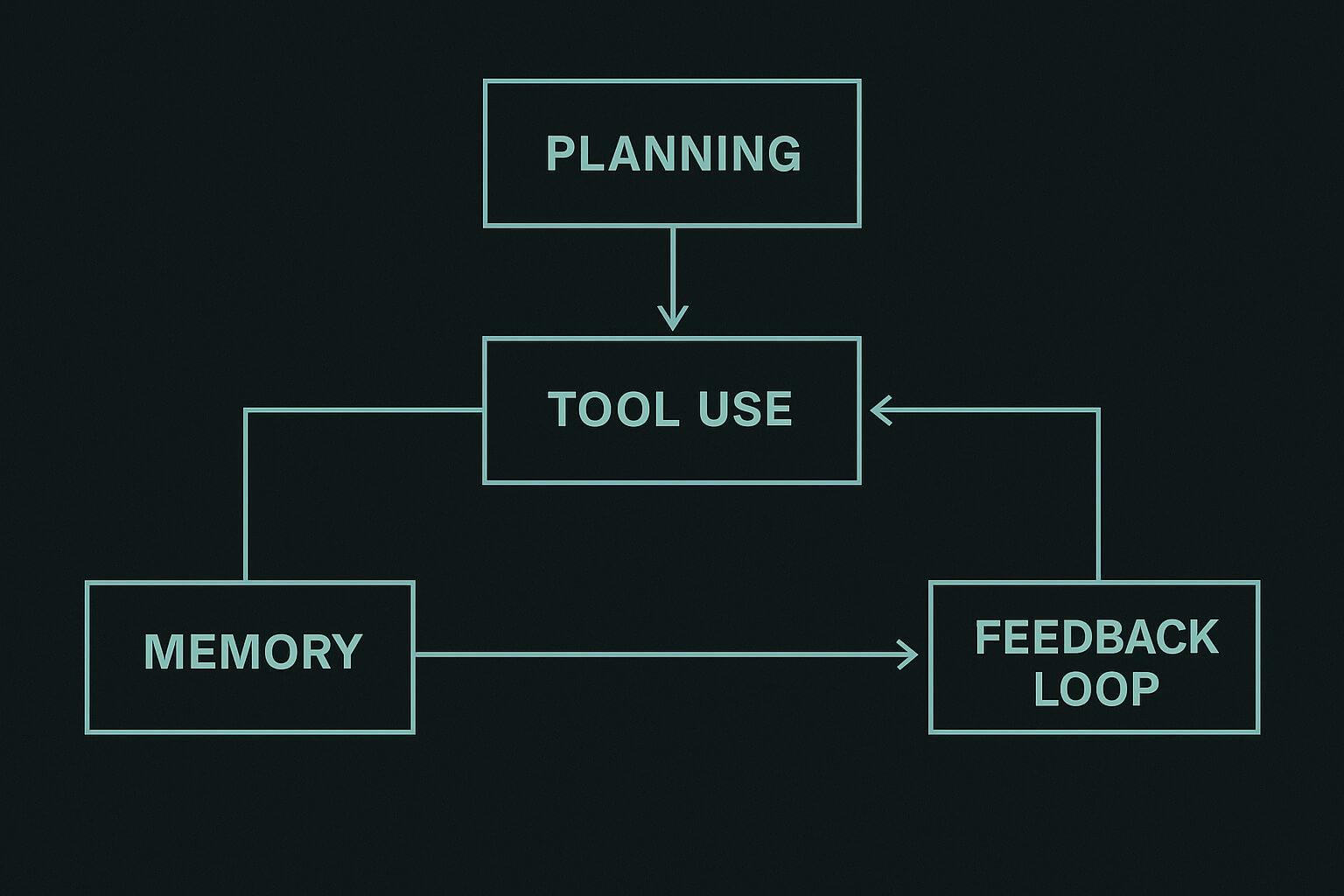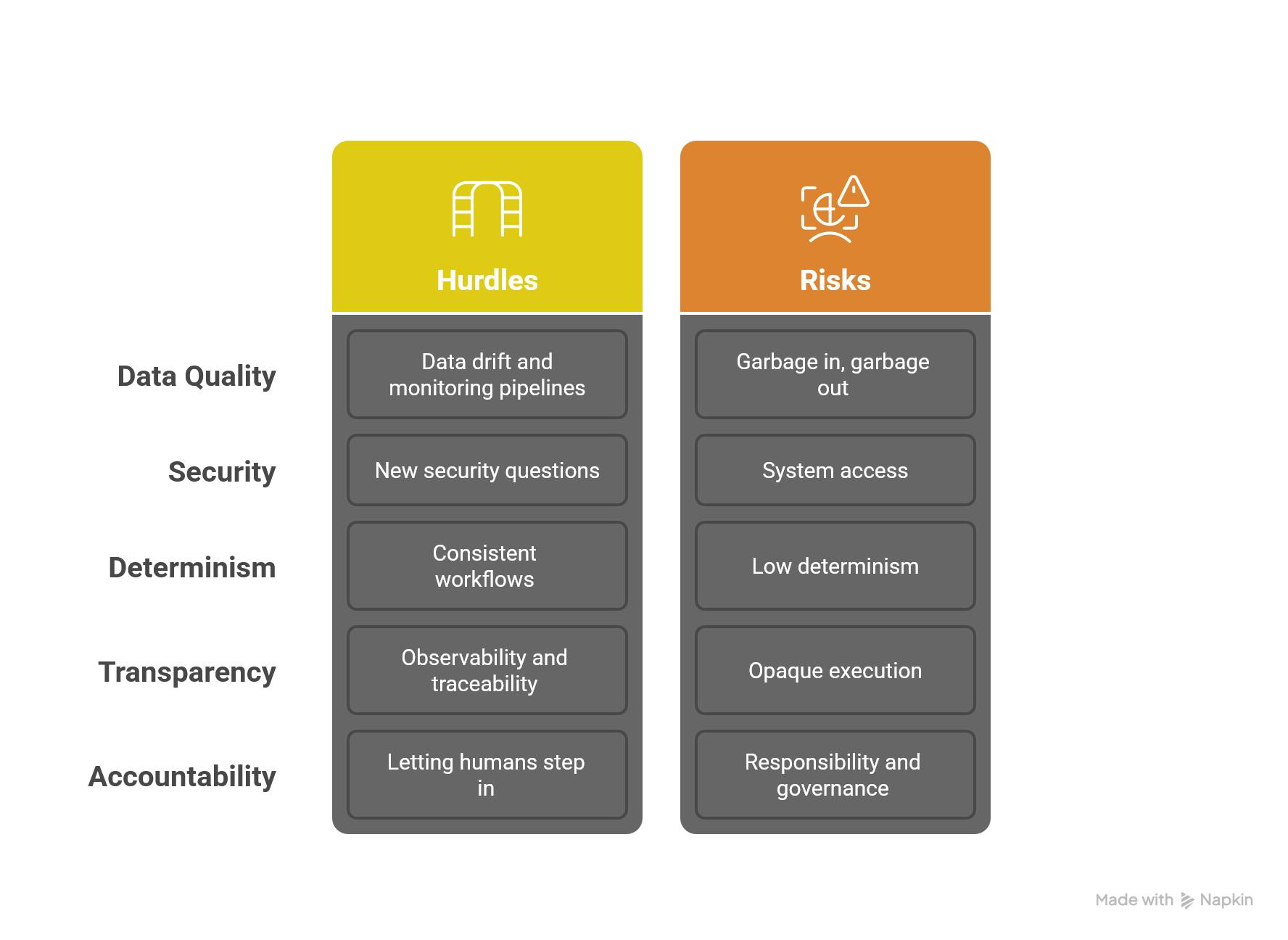
Priyaanka Arora
May 14, 2025
An Introduction to Agentic Analytics
The manner of conducting data analysis is increasingly multimodal, with a mix of drag-and-drop tools, manual coding, spreadsheets, and increasingly, conversational interfaces. As natural language interfaces become more fluent, the question shifts from how analytics is done to who is doing it, and what that means for ownership, accountability, and impact.
Today, effective analytics requires a human in the loop: prioritizing business challenges, defining metrics, writing scripts, shaping the direction of decision making. Even with LLMs generating SQL or Python on demand, it's the user steering the process. Where can we go from here?
What if direction-setting begins to move upstream, to a system that watches your KPIs, understands your business context, and initiates its own investigations? This article on agentic analytics explores what could happen when AI independently executes data analytics tasks and originates them based on an internal model of business goals.
What is agentic AI?
Agentic AI refers to artificial intelligence systems capable of autonomous action toward a defined goal. These systems are the next step to prompting; they prioritize and adapt in real time. A well-built agent can break down a goal into subgoals, choose tools, monitor progress, and revise its approach. It acts like a junior analyst or ops engineer that learns as it goes.
Under the hood, an agentic system typically consists of four main components: a planning module, a tool execution interface, a memory system, and a feedback loop. The planning module uses large language models or symbolic planners to define tasks and subgoals. The tool interface lets the agent call functions, trigger API requests, or run code snippets to complete those tasks. The memory system stores relevant context, such as results from earlier steps, historical business KPIs, or known error cases, and makes it accessible during execution. Then, the feedback loop enables the agent to evaluate its own outputs, adjust strategy, and retry failed steps if necessary.

This architecture allows agents to chain actions, adapt to new data, and operate across complex analytics pipelines with minimal intervention. Some systems also add retrieval-augmented generation (RAG) or vector search to query enterprise documentation and business rules in real time for contextualizing goals, reducing hallucinations, and improving reliability.
The Model Context Protocol (MCP) is one early attempt at operationalizing these ideas. It's a specification for how agents can coordinate through structured messaging, shared memory, and defined roles. The aim is to make agent behavior more interpretable and collaborative, allowing multiple models to work together toward shared goals without relying entirely on opaque model outputs. MCP remains experimental but is actively evolving as interest in multi-agent systems grows.
What is agentic analytics?
Agentic analytics applies the autonomy of agentic AI to data analysis. The agentic system actively monitors data streams and business objectives. It identifies anomalies, flags emerging trends, and takes initiative to dig deeper. For instance, if customer churn increases unexpectedly, an agent could run a cohort analysis, compare engagement patterns, and suggest that a recent pricing change is likely responsible.
The key difference is agency. Most AI tools assist with tasks the user initiates. Agentic systems propose their own tasks and complete them end-to-end. That creates a fundamentally different relationship between data, technology, and the people making decisions.
To understand how this could work in practice, imagine a system continuously monitoring core business metrics like revenue per user or churn. Once a deviation is detected, the agent evaluates the scope and context. If the anomaly is minor, it might assemble an email report using templated visualizations and key comparisons from the last reporting cycle. If the issue appears systemic or affects high-priority KPIs, the agent may decide to launch a deeper analysis by querying different data sources, performing causal inference, and even spinning up a lightweight data app to let stakeholders explore the data interactively.
Based on ongoing feedback and user interaction with that app, the agent can revise charts, add contextual explanations, or archive the app for future use if it determines the issue has been resolved. Maintenance tasks like updating data sources, patching broken queries, and checking alert thresholds can all be handled without human prompting. This turns the analytics stack into a living system from merely being a reporting layer.
From dashboards to decision-making
Dashboards and historic reporting still matter, to an extent. At the same time, modern organizations need tools that help them act in the moment. That’s where data apps come in, giving analysts and operators the ability to query, simulate, and trigger workflows directly from an interface.
This read/write model has reshaped analytics. Agentic AI builds directly on top of it. Agents can interact with APIs, database endpoints, and UIs similarly to how a user would. They can do it faster, continuously, and at a greater scale.
Think of it this way: dashboards help you see, while data apps help you act. Agentic analytics would help you anticipate and respond in real time.
What can go wrong with agentic AI and analytics?
Agentic analytics offers strong potential, but deploying it responsibly requires understanding technical limitations and control structures.
Much of this is still speculative or in early experimentation. While some elements like tool usage, autonomous task execution, and simple feedback loops have been prototyped or deployed in isolation, a fully production-grade agentic analytics system capable of end-to-end autonomous analysis and maintenance is still in the works.

The industry is actively working toward it, but mature, production-ready implementations are rare today. Here are some hurdles that could arise while striving toward agentic analytics:
- Data drift and monitoring pipelines: If an agent operates on live data streams, it's essential to implement real-time data validation, schema enforcement, and drift detection. If the inputs change format or contain errors, the agent can misinterpret results or miss important trends.
- System access: Because agents interact with production systems, strict authentication, role-based access control, and scoped permissions are required.
- Workflow determinism: Stochastic components like LLMs require techniques such as prompt templating, temperature tuning, and fallback logic to produce consistent results.
- Observability and traceability: Frameworks like LangChain and OpenAgents provide hooks for execution tracing and replayability. This helps identify failure points and build confidence in the way the agents work.
- Letting humans step in: Even smart agents need rules about when to pause for review, like when something looks wrong, or before big changes go live.
By building agentic analytics systems with engineering-grade standards, data teams can gain higher efficiency without introducing unacceptable risk. Some of that risk is inherent to the nature of using your data with LLMs, such as:
- Garbage in, garbage out: Autonomous systems can amplify your impact, and also amplify your data quality issues if you have them. If your inputs are flawed, agentic systems get to wrong conclusions faster.
- New security questions: Agents need access to systems and data to act. That opens up permissions, audit, and vulnerability concerns that many organizations aren’t yet equipped to handle.
- Low determinism: LLMs vary in output. When outcomes shift, trust erodes. How do you verify findings or replicate results?
- Opaque execution: At scale, agents create complex chains of action. Without proper observability, it becomes hard to know what happened and why, which undermines accountability.
- Responsibility and governance: If an agent makes a business decision or triggers a workflow and something goes wrong, who’s accountable? These questions still lack clear answers in most companies.
An imagined future with agentic analytics
Try a thought experiment with me. Let’s say a clean energy company manages a network of solar installations through a central data app. Each site has IoT sensors, weather feeds, and energy yield data. Field operators monitor that data manually or through alerts.

Now add an agentic analytics layer. The system notices that output is lower than projected at several sites. It cross-references solar irradiance, recent updates, and inverter performance. It finds that installations using a specific firmware version are underperforming. Based on this, the agent spins up a tailored data app using Plotly AI. It populates it with plots comparing historical and current performance, embeds a root cause summary, and links the sensor data feed for ongoing monitoring. The agent deploys this app to the internal analytics portal with access controls, sets up a daily refresh routine, and adds a note in the maintenance queue that this data app can be archived once metrics stabilize.
Without being prompted, the agent drafts a summary report, includes diagnostics, sends it to the ops lead, and opens a support ticket with the inverter vendor.
It still feels a bit sci-fi.
An agent that spots a performance dip, builds and deploys a data app, alerts the team, kicks off a fix without being asked, and yet, this isn’t as far off as it used to be.
The fact that we can even talk about this seriously, without waving our hands too much, is worth paying attention to. It’s early, and making this dream real is going to take rigor, guardrails, and healthy skepticism. But it’s an exciting direction to be heading in.